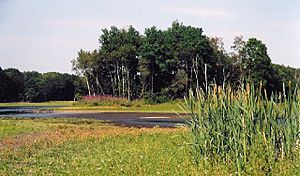Brown Moss facts for kids
Brown Moss is a very special wetland area in Shropshire, near the town of Whitchurch. It's a place full of amazing wildlife and plants. You can visit Brown Moss and explore its walking trails. The word 'moss' in its name means a type of peat bog, which is a wet, spongy area where dead plants build up over time.
Contents
What is Brown Moss?
Brown Moss covers about 31 hectares (that's like 76 football fields!). It's located just 2 kilometers (about 1.2 miles) from Whitchurch, east of the A41 road. People in Whitchurch might have used this area to cut peat for fuel since the Middle Ages. It was also considered a shared piece of land for everyone. In 1952, Shropshire County Council bought the site to make sure people could always visit and enjoy it.
Why is Brown Moss so important?
Brown Moss is recognized as a very important natural place. In 2000, it became a Local Nature Reserve. It's also a Site of Special Scientific Interest, which means it's protected because of its special plants, animals, or geology. Even more, it's a Special Area of Conservation and a Ramsar site. Being a Ramsar site means it's a wetland that is important all over the world!
Wildlife and Nature at Brown Moss
Brown Moss has many different types of natural areas. You'll find marshes, pools, heathland, and woodlands. These different habitats are home to more than 200 kinds of rare plants, like the floating water plantain.
Animals you might see
Lots of different animals live at Brown Moss. You might spot common newts and the larger great crested newts. Birds like great spotted woodpeckers and jays are also common. About 30 types of birds actually build their nests here! Many wetland birds visit too, such as Canada gooses, mallards, and great crested grebes. In the summer, look for tiny froglets (baby frogs) and colorful dragonflies near the water and trees.
How Brown Moss was formed
Brown Moss is a flat area that was created a very long time ago, at the end of the last Ice Age. This was over 10,000 years ago! When the giant glaciers melted and moved back, they left behind big chunks of ice. As these ice chunks melted, they formed deep pools in the ground called kettle holes.
Peat is still forming at Brown Moss today. A special plant called Sphagnum moss is very important for making peat, and you can find lots of it growing here.
Visiting Brown Moss
Brown Moss has several walking paths, including one that's great for families. However, the ground can often be very wet and muddy, so it's a good idea to wear waterproof boots or other suitable footwear.
Protecting the wetland
Brown Moss is facing a challenge from a fast-growing plant called Crassula helmsii, also known as New Zealand Pygmy Weed. This plant is not native to the area and can quickly cover and smother other plants. To help stop it from spreading and to protect the delicate marsh habitats, visitors are asked to stay on the marked paths and avoid walking near the edges of the pools.
How the site is looked after
To keep Brown Moss healthy, people regularly remove scrub (small bushes) and young trees. If they didn't do this, the area would turn into a dense forest, and the important pools and marshes would disappear. Shropshire Council is also thinking about bringing in animals to graze, which can be another way to manage the land and keep it open for wildlife.



